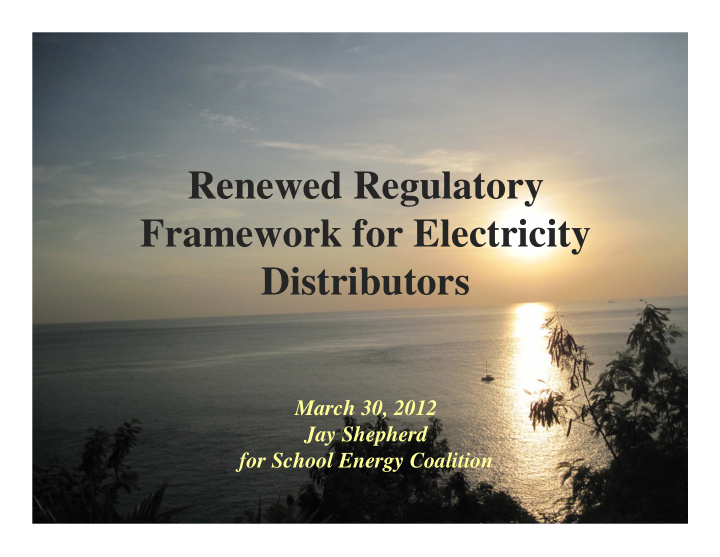



Renewed Regulatory Framework for Electricity Distributors March 30, 2012 Jay Shepherd for School Energy Coalition
School Energy Coalition • Who We Are • Coalition of seven school board/management organizations • 5000 schools with 2 million students • Spend $550 million per year on energy • Intervention Principles • Always look for the win-win solution • “Walk softly but carry a big stick” • Think long term
Issues The Board’s “market proxy” role in setting LDC rates The special problem of infrastructure investment
The Market Proxy Responsibility • Basic Purpose: Control of monopoly rents • Approved by Canadian and U.S. courts • Additional Purpose: Market imposes cost discipline; so should market proxy • Cost of service is not market-like – market resists “cost-plus” pricing
Price Cap IRM as Market Proxy • Assumes prices change based on cost changes in a predictable pattern • Measures empirically the past relationship between major inputs and price (i.e. revenue requirement) • Captures all costs that impact price • Prima facie a pure market proxy
Gas Utilities • SEC’s oft-repeated goal – long term stable rates at less than inflation • 2007 Base Year, i.e. 6 years so far • 2013 Base Year, could extend to 2018 or beyond • Long term rate stability • Utilities prospering under this predictable revenue regime
Alternatives/Strawman/TPBR • Classic debate between top-down and bottom-up budgets • Top down is the business paradigm – Projects/priorities fight for resources – Assumes business is a price taker • Bottom up is a government paradigm – In theory, there is no upper limit on cost because no market to set price • Gov’t policy selected the business model
Infrastructure Investment • Show us the evidence of the “problem” • Capital spending is a zero-sum game • Different LDCs have different capital situations
“Where’s the Beef?” • The answer is not “read some rate applications” • The answer is not Asset Condition Assessments • The answer is empirical data, collected and analyzed rigorously
Asset Condition Assessments • Management tool • Gathering information on the state of the system is valuable • Tell you nothing about how much your capital budget should be • Every organization has an ACA showing lots of work to be done
Infrastructure Spending Choices • Zero-Sum: A dollar of electricity infrastructure built is a dollar of school infrastructure not built • True for many other customers • Irrelevant whether rates “smoothed” – it is still money out of our pockets • Show us why your infrastructure should take precedence over ours
Different LDC Situations • Starved for capital? – Detailed vintage data by asset class • Customer growth impacts – Track capex relative to growth • New requirements – Components of rate base (net) driven by changes in the nature of the product • Geography
10 Largest LDCs - 2010 Yearbook Data PPE per Capex per Capex % Utility Customer Customer Depr. London $1,330 $180.79 166.60% Horizon $1,420 $165.49 157.75% Veridian $1,484 $247.32 211.95% Kitchener $1,699 $240.53 212.60% Ottawa $1,772 $297.64 207.17% Brampton $1,928 $265.94 202.37% PowerStream $2,116 $285.99 201.28% EnWin $2,156 $218.58 151.43% Enersource $2,295 $259.09 137.90% Toronto $3,066 $601.45 255.36%
What Should the Board Do? • Understand the problem before trying to solve it • Establish a base of standardized data including vintage, customer growth, etc. • Identify the specific problem that requires incremental spending • Ensure that all sources of that spending are canvassed, not just ratepayers
Incremental Capital Module • Current average spending by LDCs – 224% (or 191%) of depreciation • Will increase with IFRS • Not apparently influenced by whether on COS or IRM • No correlation with ROE • No apparent need to loosen up the ICM • Impact would be rate increase of +2%
Recommend
More recommend